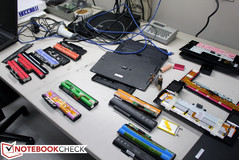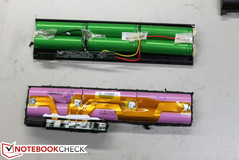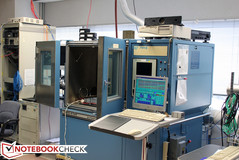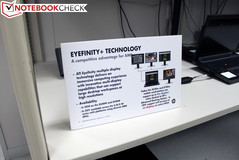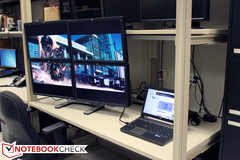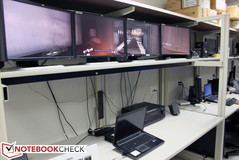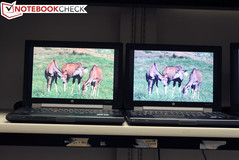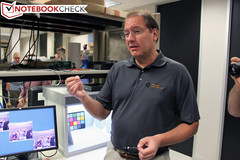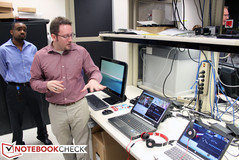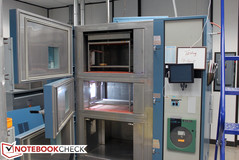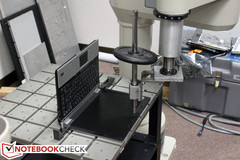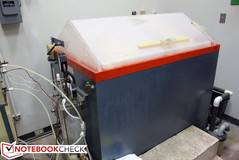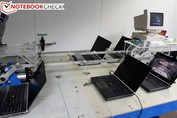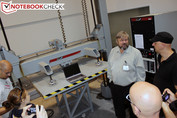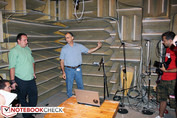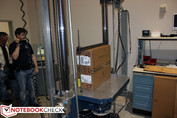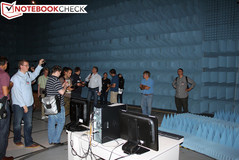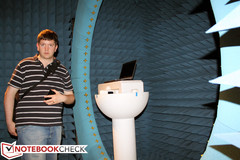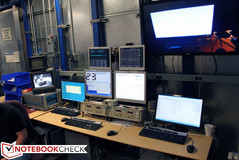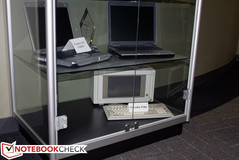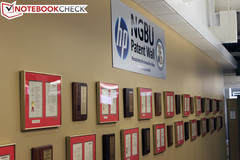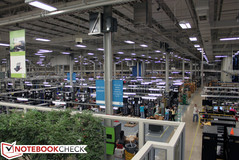NBC on location: HP Labs in Houston, Texas

The question why a notebook from the business class generally costs several hundred Euros more than a comparative model from the consumer palette, is probably one that many buyers ask themselves. The fact that considerably more than a simple comparison of Megabytes and Gigahertz is involved, was demonstrated by the PC giant HP as part of a tour for selected technology journalists through its 'holy halls' at the company headquarters in Houston.
We were on location for several days, and looked over the shoulders of technicians, constructors and designers on your behalf.
Engineering lab, battery, multimedia, software and audio/visual technology
Our first stop was in a laboratory and mesh of workshops where especially batteries, displays, webcams, and speakers are tested. That an original HP battery is drastically different compared to a cheap Asian copy, was for instance demonstrated in the Battery Lab. HP for example uses conductor strips throughout in their battery packs, while alternative products generally adopt using simple cables. In addition, HP also wraps the individual cells in a type of protective cover, a practice that is also not employed in more affordable alternatives. The added value for the customer as a result should be a significantly lower likelihood of failure, and improved security against overheating and material degradation over the course of several years. HP touts that the additional costs of production are relatively small (several cents) compared to the additional usage potential, whereby replacement batteries are frequently considerably cheaper than the relevant qualitative branded products.
In the adjoining room, different alternative solutions were destroyed in a controlled manner - in other words overheated and over exerted, until the cells went up in flames. This also enables an analysis of the effectiveness of a diverse set of security features (charging circuitry, overheating,...), that HP integrates into its batteries.
Particular attention was paid to the demonstration of the HP Dreamcolor displays during the course of the tour, which is supposed to provide for the best possible viewing angle stability and accurate color presentation with its IPS panels. These panels are only available in the 15 inch Workstation 8560w, and the 17 inch Workstation Elitebook 8760w, whereby we already had the predecessor 8740w with a Dreamcolor display for review. A direct comparison with the otherwise rather blue tinted conventional TN displays showed a clear difference.
The promotional demonstration additionally covered Eyefinity, which, although actually a technology from AMD, allows up to 5 displays to be accessed at the same time. A technology that could be especially interesting for use in the banking or trading domain. Eyefinity is available with all current Elitebooks that use a dedicated graphics card.
The fact that the webcam and audio quality of Elitebooks is also a relevant aspect is demonstrated in the subsequent visit to the Multimedia Software Lab. In this case individual webcams are tested for their color representation and picture quality, as well as fine tuning the audio quality supported by SRS audio. That HP Elitebooks, at least as far as the integrated speakers are concerned, aren't able to accomplish any miracles, was observed by us several times during previous tests. Staying true to their colors, the professional office devices therefore provide the expected audio quality. For other application areas, HP for example provides the HP Envy series with Beats Audio.
Reliability and materials lab
It got more interesting in the following areas, where the quality of the adopted materials, and the general durability and reliability of the devices in particular are addressed.
In these areas, more or less everything conceivable is tested: Starting with a test of the usage temperatures in an 'Altitude Chamber', which simulates the operation in extreme elevations with the corresponding air pressure conditions, in which the cooling system still has to perform its function just as well. Followed by special shaking plates, which abuse the components and particularly their contacts and attachments to the extreme. And corrosion chambers, in which devices are used while subjected to especially adverse air humidity conditions.
Faithfully adhering to the slogan "We bake it, shake it and brake it!", only the fewest Elitebooks find their way back to the workshops in one piece again. The goal in all instances of the testing phases, is attaining the necessary feedback for the respective construction and design teams in the early stages of development, in order to provide the information that is required for the finished products to achieve the expected high standards, and conform to the different worldwide standards for various application scenarios.
Analysis of faults is performed by advanced devices, such as real-time X-ray equipment, an electron microscope, and devices for assessing materials.
Constant testing of the hinges, keyboard, and other moving parts, are among the more benign aspects. When it comes to the pressure tests of the individual components and the whole device, as well as the fall tests, and extreme vibrations, the more robust counterparts stand out.
Thus, it was for example demonstrated that the aluminum-magnesium lid on the Elitebooks is able to withstand pressure in its center of up to 280 pounds, corresponding to about 130 kilograms, concentrated on an area approximately the size of a 2 Euro coin, without damaging the sensitive display panel underneath it. The display hinges have to survive about 25,000 folding cycles without damage, in order to be adopted for series production. This equates to about 3 years of use, assuming a daily opening and closing of 25 times, something that should also live up to especially intensive usage.
Shock, sound and vibration lab
Intensive tests are also carried out for the system noise, which should remain within limits during diverse operating scenarios. Special anechoic chambers, fitted with numerous measurement devices, enable an assessment according to the highest standards.
Special attention is lastly also given to the packaging of the devices. In diverse fall tests, and on an oversized shaking plate, the effectiveness of the different materials and packaging concepts are analysed as to how well they can protect their contents. The aim to achieve a 'green' solution, while also protecting the products the best way possible, provides for a challenging task.
Electromagnetic lab
The final stop was the electromagnetic lab, in which the invisible emissions of the device are assessed, along with the integrated wireless modules. Building replicas made of synthetic materials, as well as rooms hermetically sealed against all types of RF interference can also be found in the HP complex.
Operating the Elitebook in the medical field for example, will quickly make it apparent that electromagnetic interference should be taken seriously, since surrounding highly sensitive devices could be disturbed.
The smooth operation of the adopted WLAN and WWAN modules also has to be tested however, and should provide the best possible sending and receiving of signals in the respective case.
Verdict
The days at HP's center in Houston were interesting, and also left a lasting impression. The elaborate testing carried out for the HP Elitebooks was definitely impressive, even if it can be assumed that other qualitative manufacturers subject their business devices to similar hardships, in order to achieve the best possible results. HP of course tries to set itself apart from the competition with special construction details.
The fact remains: The business branch among laptops requires an entirely different effort in terms of development for manufacturers than more affordable devices. That these devices finally also come for a premium compared to their consumer counterparts, thus becomes understandable, and is also reimbursed to the customer by the significantly improved quality and reliability.
The three years manufacturers warranty, with which business notebooks are generally supplied upon delivery, can probably be interpreted more as a bonus for customers. More appropriately, manufacturers could allow themselves to guarantee a significantly longer failure free operation of relevantly tested high quality products - even if a considerably more intense daily use can be expected compared to the usual home notebook.




